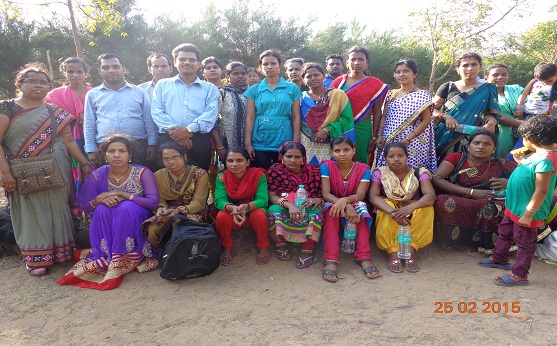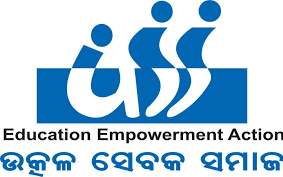[su_row]
[su_column size=”3/5″] The fight against HIV & AIDS particularly in rural areas becomes more pronounced in view of stigma and discrimination surrounding HIV, resulting in poor access to health care, gender inequality and above all infections going undetected. The existing primary health care system has limited scope and capacity to deal with the sensitive issues like HIV, sexuality and drug use. Keeping this in mind, link worker scheme has been conceived for building the capacity of the rural community in fighting HIV.
Utkal Sevak Samaj implementing the link Worker scheme Project in Cuttack District of Odisha with funding from NACO through OSACS as lead partner. The focus of the project is HIV testing, Follow up of returnee migrants and linkages with government facilities and social services. Linking with the marginalized sub populations to the public health services for STI, ICTC and then their follow up are key areas that are addressed by these link workers.
Link workers scheme is aimed at reducing the vulnerability of the most at risk adolescents, especially vulnerable adolescents and high risk groups in the rural areas as well as mitigating the impact of HIV on those who are already living with the virus.
[/su_column]
[su_column size=”2/5″]
[jcolumns][jbutton color=”orange” square=”yes” size=”medium” link=”http://utkalsevaksamaj.org/?p=171″]
Donate Now[/jbutton]
[jcol/][jbutton color=”green” square=”yes” size=”medium” link=”http://utkalsevaksamaj.org/?p=152″]
Meet Team[/jbutton]
[jcol/][jbutton color=”blue” square=”yes” size=”medium” link=”http://utkalsevaksamaj.org/?p=772″]
Blog Section[/jbutton]
[/jcolumns]
[jaccordion size=”small” theme=”cupertino” active=”4″]
Child Development::
[su_list icon=”icon: child” icon_color=”#0f6bee”]
[/su_list]
[jacc/]
Disaster Management & Mitigation::
[su_list icon=”icon: bolt” icon_color=”#e4e322″]
- Community & Panchayat level Contingency Plan involving PRI Members
- Disaster Preparedness
- Disaster Rehabilitation
- Emergency Response
[/su_list]
[jacc/]
Education::
[su_list icon=”icon: book” icon_color=”#f639d0″]
- Education for Anganwadi Workers on HIV & AIDS
- Education to PRI Members on different schemes for social security
- Life Skill education to adolescent girls
[/su_list]
[jacc/]
Health::
[su_list icon=”icon: stethoscope” icon_color=”#f29919″]
- Care and support to people living with HIV & AIDS
- Community based mental health
- HIV and AIDS Awareness
- Link Worker Scheme
- Prevention and control of TB & Malaria
- Prevention of Parent to child Transmission
- Reproductive Mother & child health
[/su_list]
[jacc/]
Integrated Community Transformation::
[su_list icon=”icon: building” icon_color=”#6efff6″]
- Community Development
- Income Generation programs for Poor & Marginalized
- Promotion of Self Help Processes among Women
- Promotion of sustainable agriculture among tribal women
- Strengthening local self Governance and advocacy on rights of marginalized
- Training of Women PRI representatives on their duties and rights.
[/su_list]
[jacc/]
Lobby & Advocacy::
[su_list icon=”icon: bullseye” icon_color=”#000000″]
- Biodiversity and related to Social Security issues
- Blood safety issues
- Highlight the rights and needs of PLHIVs
- Rights of Patients through Odisha Rajya Rogi Adhikar Mancha
[/su_list]
[/jaccordion] [/su_column]
[/su_row]
[su_row]
[su_column size=”1/3″]
ACTIVITY

[/su_column]
[su_column size=”1/3″]
[/su_column]
[su_column size=”1/3″] [/su_column]
[/su_row]
[su_tabs][su_tab title=”Objective“]
The scheme aims at building a rural community model to address the complex needs of rural HIV prevention, care and support requirements in selected geographies.
The scheme aims at reaching out to rural population who are vulnerable and are at risk of HIV /AIDS in a non stigmatized enabling environment.
The Scheme aims at improving access to information materials, commodities (condoms/needles/syringes) through collaborating with nearest TI or government health facilities, testing and treatment services ensuring there is no duplication of services of resources.
The scheme aims at improving linkage to other social and health benefits provided by other line departments in line with local norms, regulations suitable for vulnerable populations.
[/su_tab]
[su_tab title=”Achievements“]
Presence of 40 Link Workers in 150 villages in five blocks (Cuttack Sadar, Tangi – Choudwar, Mahanga, Salipur & Athagarh ) of the Cuttack District.
Covered 49755 people throughout reach activities.
4996 people used services of ICTC and got tested HIV.
Mainstreaming HIV & AIDS activities were carried out with various Departments of Odisha.
One disable (Polio) girl supported through CDMO and got disable certificate and pension scheme although it is beyond this project.
[/su_tab]
[su_tab title=”Project Area & Population Covered“]
100 Villages in 4 Blocks (Tangi- Choudwar, Mahanga, Salipur and Athagarh ) of Cuttack District.
High risk Groups-408 (FSW-319, MSM-58, and IDU-22) Bridge Population: 10851 (Truckers-1868, Migrant Male-8515, & Migrant Female-468), Vulnerable Population: Male-20509, Female-20153, and PLHIV-54.
[/su_tab][/su_tabs]
Case Study:- Migrant and HIV in Kayalapada, a Rural Cuttack
[su_note]
Total Population of Kayalapada GP:-5969
Number of Migrants in Kayalapada GP:-433
HIV Prevalence in Kayalapada-0.25 %
HIV Prevalence in Migrants-1.15 %
Link Worker Scheme has linked migration to increase in HIV transmission in Odisha migrants act as a bridge population spreading HIV between Urban and Rural areas, and between high risk and low risk groups.
Being mobile in and of itself is not a risk factor of HIV infection. It is the situations encountered and the behaviors possibly engaged in during mobility or migration that increase vulnerability and risk regarding HIV & AIDS. Despite being an important driver of the HIV epidemic in Odisha, data on migrant sexual behaviors is limited. Moreover, migrants have been found to have low risk perception of HIV transmission compared with other high risk groups.
For example, in Cuttack there is a GP named Kayalapada. Where are 5 families infected with HIV and all families bread winner was migrant and infected with HIV. Now there wife and kids are also living with HIV and suffers a lot. As the total population of Kayalapada GP is 5969 and out of them 5 PLHIVs resided in this GP.
[/su_note]
The Services provided under link worker scheme are:
Community outreach to establish Linkages with Services: Link Workers reach out to those vulnerable populations who are not able to access to HIV related services. During these project period 49755 beneficiaries under HRG, bridge and vulnerable population has been covered through different activities. 4996 got tested HIV, 270 clients received STI treatment among them. Around 3000 people reached out through cultural activities and 49755 people through IEC activities.1123 village volunteers strengthened on STI/HIV/AIDS and condom demonstration.
Advocacy: The focus of advocating for availability of quality services and reduction of stigma and discrimination against HRG & PLHIV.11 Advocacy done with PRI members and Block officials on to strengthen social security scheme.
Community Mobilization: Public events such as World AIDS Day, National Youth Day & International Women’s Day organized where 3956 people participated.
